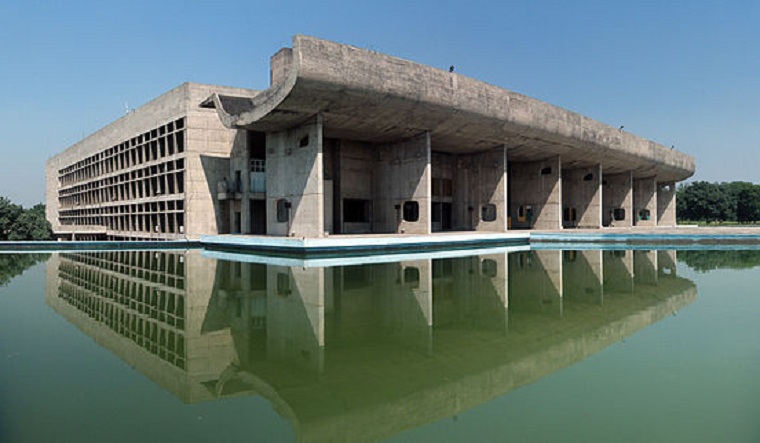The City Beautiful, Chandigarh, has three suitors vying for control over it. In the 55th year of the city coming into being as a Union territory, the issue of who controls it has turned into a political tug of war.
Chief Minister M.L. Khattar-led Haryana government passed a resolution in the state Assembly on Tuesday saying it will not give up its claims over Chandigarh and asked the Centre not to disturb the balance of power in the joint state capital, it shares with Punjab. Haryana also asked for sharing of water it was promised from the Ravi and the Beas, the two rivers which flow through Punjab.
Haryana called a special one-day session to pass the resolution, after the Punjab Assembly passed a resolution in March demanding Chandigarh be given to the state. The Aam Aadmi Party-led Punjab government had raked up the decades-old politically sensitive issue after the Centre's two recent orders stirred up a row. Poll-bound Himachal Pradesh, too, has claimed that it has 7.19 per cent stake in Chandigarh. The state politicians cited a 2011 Supreme Court order to stake claim. Demands are being made in Himachal to pass a resolution to keep the balance of power over Chandigarh.
In Chandigarh, Punjab and Haryana share a common High Court, and have their state assemblies in the same complex. Both the states have their governments stationed in the capital.
Punjab's claim over Chandigarh has been an emotional one, and deeply political, too. After partition, Lahore, considered as the cultural centre of Punjab, went to Pakistan, and Indian Punjab was left without an equivalent. Then prime minister Jawaharlal Nehru entrusted the task of building a modern city to French architect Le Corbusier.
States of Himachal and Haryana were carved out of Punjab in 1966, and Chandigarh and Himachal were deemed as UTs at that time. Handing over of Chandigarh to Punjab was one of the main demands of the Akali Dal, and found mention in Anandpur Sahib resolution, which is sometimes termed as precursor for radicalism in the state. The centre had promised to give Chandigarh to Punjab in 1970 and later under the 1985 Rajiv-Longowal accord also. Recently, Akali Dal MP Harsimrat Kaur Badal had asked the accord to be ratified to shift Chandigarh to Punjab.
Under the Punjab Reorganisation Act in 1966, Chandigarh became a UT and employees in the city were shared in 60:40 ratio between Punjab and Haryana. While Haryana, due to its proximity to Delhi, developed cities like Gurgaon and Faridabad, the Punjab did not have a modern city for it. Chandigarh, however, continued to be governed by Punjab laws.
It changed last month when Home Minister Amit Shah announced during his visit to the city that Chandigarh employees will get central government status thus making them eligible for better salaries and emoluments. This move was hailed by the UT employees but it caused consternation in Punjab which saw it as another attempt by New Delhi to snub the border state. All political parties were up in arms against the move.
This was the second decision by the Centre to cause consternation in the state. Earlier, in February, the Centre changed the rules for Bhakra Beas Management Board, a body which manages the river systems and hydro projects in Punjab, which is the source of water and power for states of Punjab, Haryana, Himachal, Chandigarh, Rajasthan and Delhi. The body had one member each from Punjab and Haryana. However, the Centre changed the rule to bring technical people as members, and allowed their hiring from across the country. Both Punjab and Haryana saw it as affront to their regional aspirations. Being a BJP-ruled state, Haryana was muted in its response, but it became a political issue in Punjab, where farmers too warned of agitation.
The BBMB was set up after the Indus Water Treaty, 1960 was signed between India and Pakistan. The waters of three eastern rivers: the Sutlej, the Beas and the Ravi were allotted to India for exclusive use. “A master plan was drawn to harness the potential of these rivers for providing assured irrigation, power generation and flood control. Bhakra and Beas Projects form major part of the plan, and were established as a joint-venture of the erstwhile states of Punjab and Rajasthan,” a BBMB note said.
The Bhakra Management Board was constituted under the Punjab Reorganisation Act, 1966. As Beas project was also handed over to it, the board was renamed as Bhakra Beas Management Board.
Given its own administrative structure, the city is better managed than other cities in both Haryana and Punjab. The locals largely want the status quo to continue as it provides the city better upkeep and management. Though there has not been any serious demand to change nature of Chandigarh in the recent years, the current tug of war can escalate if parties in Punjab turn it into a political issue.





